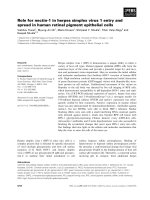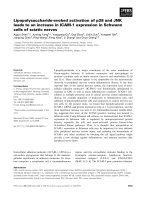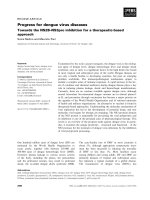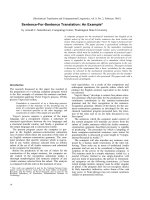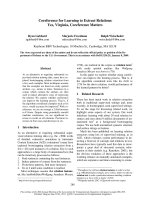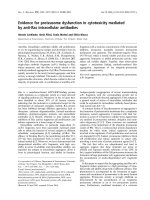Báo cáo khoa học: " Serosurveillance for Japanese encephalitis, Akabane, and Aino viruses for Thoroughbred horses in Korea" docx
Bạn đang xem bản rút gọn của tài liệu. Xem và tải ngay bản đầy đủ của tài liệu tại đây (276.55 KB, 5 trang )
JOURNAL OF
Veterinary
Science
J. Vet. Sci. (2008), 9(4), 381
385
*Corresponding author
Tel: +82-31-467-1731; Fax: +82-31-467-1795
E-mail:
Serosurveillance for Japanese encephalitis, Akabane, and Aino viruses
for Thoroughbred horses in Korea
Dong-Kun Yang
1,
*
, Byoung-han Kim
1
, Chang-Hee Kweon
1
, Jin-Ju Nah
1
, Hyun-Joo Kim
1
, Kyung-Woo Lee
1
,
Young-Jin Yang
2
, Kyu-Whan Mun
2
1
National Veterinary Research and Quarantine Service, Anyang 430-824, Korea
2
Equine Hospital, Korea Racing Authority, Gwacheon 427-711, Korea
Recent global warming trends may have a significant
impact on vector-borne viral diseases, possibly affecting
vector population dynamics and disease transmission. This
study measured levels of hemagglutination-inhibition (HI)
antibodies against Japanese encephalitis virus (JEV) and
neutralizing antibodies against Akabane virus (AKAV) and
Aino virus (AINV) for Thoroughbred horses in Korea. Blood
samples were collected from 989 racehorses in several
provinces, between October 2005 and March 2007. Sera
were tested using either an HI assay or a virus neutralization
test. Approximately half (49.7%; 492/989) of the horses
tested were antibody-positive for JEV. The HI titer against
JEV was significantly correlated with racehorse age (p
<
0.05). Horses with an HI antibody titer of 1
:
160 or higher
accounted for 3.9% of the animals tested, indicating that
vectors transmitting arthropod- borne viruses bit relatively
few horses. In contrast, 3.8% (19/497) and 19.5% (97/497) of
horse sera collected in March 2007 were positive against
AKAV and AINV, respectively. The presence of antibodies
against AKAV and AINV may indicate the multiplication of
AKAV and AINV in these horses.
Keywords: arbovirus, racehorse, serosurveillance
Introduction
Populations of Korean horses, including native ponies,
have been gradually increasing with the growth of the
racing industry. Approximately 23,000 horses including
8,000 Thoroughbred horses and 15,000 other breeds (Jeju
horses and Jeju racehorses) are raised on 1,142 premises in
Korea [12]. Racehorses are important industrial animals in
Korea, and therefore great care has been taken to prevent
arbovirus infections in these animals. However, there is
growing concern that global warming may affect the
prevalence of vector-borne diseases and, consequently, the
racehorse industry.
Japanese encephalitis virus (JEV) is a Flavivirus belonging
to the family Flaviviridae. Japanese encephalitis (JE) is a
typical zoonosis caused by JEV and is transmitted by several
species of mosquito, principally Culex tritaeniorhynchus,
which breed in small pools or paddy fields [16]. JEV can
infect both domestic and wild animals, including swine,
horses, chickens, reptiles, and grey herons. Although adult
animals do not develop clinical signs, they may serve as viral
reservoirs or amplifying hosts. After JEV was first identified
in Koreans in 1946, a number of JE cases were reported in
domestic animals as well as in humans through the 1950s and
1960s [9]. When an attenuated live vaccine was developed
and administered to both swine and horses in 1980, the
number of outbreaks in animals was significantly reduced
[8]. Recently, JEV has been considered an emerging virus,
with new JE cases being reported in regions of Australia and
Africa [15]. JEV has been identified from a diseased horse
in Japan in 2006 [19] and JEV antibodies were detected in
52% of Indonesian horses [18]. A horse that is naturally
infected with JEV displays several symptoms, such as
anorexia, lethargy, and fever, and is considered to be a
dead-end host [19]. There have been no reports on horses that
were clinically infected with JEV in Korea until recently;
however, there are reports of other infected animals in Korea
[20,21]
Akabane virus (AKAV) and Aino virus (AINV) are
members of the Simbu serogroup, genus Orthobunyavirus,
family Bunyaviridae, and consist of three segments of
single-stranded negative RNA. These two viruses are
responsible for many reproductive disorders, including
abortion, stillbirth, and congenital malformation, in
ruminants [13]. AKAV and AINV are transmitted via
biting midges such as Culicoides (C.) brevitarisis, C.
oxystoma, and C. nebulous [7]. Although AKAV and
AINV are not known to cause illness in horses, there have
382 Dong-Kun Yang et al.
been several reports on the presence of antibodies against
arboviruses in these animals [2,3].
The risk of exposure of domestic animals to arbovirus-
infected mosquito bites depends on several environmental
factors, including climate, host abundance, and vector
populations. Among the arboviruses, JEV, AKAV, and AINV
are the most significant vector-borne viral agents in South
Korea. Sero-epidemiological studies are critical for predicting
potential outbreaks of vector-borne viral diseases among
horses. These studies also provide data for establishing a
system to prevent these diseases. In our study, we conducted
a serological survey to determine the prevalence of
antibodies against JEV, AKAV, and AINV in Thoroughbred
horses in Korea.
Materials and Methods
Viruses and cells
The strain of JEV used as an antigen for the hemagglutination
inhibition test was KV1899. This particular strain was
isolated from Korean pig blood in 1999 [20]. The strains of
Akabane and Aino viruses used for the virus neutralization
test were K-9 and KSA9910, respectively [11]. The latter
two viruses were propagated using Vero cells cultured in
α-minimum essential medium (MEM; Gibco BRL, USA)
supplemented with antibiotics (100 IU/ml penicillin and 100
μg/ml streptomycin), an antimycotic (0.25 μg/ml amphotericin
B), and 5% fetal bovine serum (FBS; Gibco BRL, USA).
Uninfected cell cultures were used as negative controls.
Collection of sera
For the seroprevalence study, blood samples were collected
from thoroughbred racehorses in several provinces of
Korea, between October 2005 and March 2007. The species
of racehorse tested in this study was Thoroughbred, and
about 70% of the racehorses were produced in Korea; the
others were imported from several countries such as the
United State of America, Australia, Japan, New Zealand,
India and Ireland. Most of the racehorses are vaccinated once
a year against Streptococcus equi, JEV and equine influenza
virus. None of the horses used in this study had been
vaccinated against AKAV or AINV. Clotted blood samples
were separated by centrifugation, and the sera were stored
at -20
o
C until use.
Hemagglutination inhibition (HI) test
To estimate JEV antibody prevalence in horse sera samples,
an HI test was performed in 96-well microplates, using
slightly modified standard methods. Using a sucrose-
acetone extraction method, viral antigens were prepared
from the brains of suckling mice infected with the Korean
isolate of strain KV1899 [1,20]. Briefly, the sera were treated
in round bottom microplates (96-well). To remove non-
specific inhibitors, 10 μl of serum and 50 μl of 4% bovine
albumin were mixed with 40 μl of 25% kaolin (Sigma, USA)
and incubated for 30 min. After pipetting, the kaolin was
removed by centrifugation at 3,600 rpm for 15 min in a
microfuge. The resultant clear supernatant was mixed with
5 μl of packed goose erythrocytes to remove any natural
agglutinins. After incubation for 1 h at 37
o
C, the treated
serum was separated from the goose erythrocytes by
centrifugation. For the HI test, four to eight HA units of JEV
(in 25 μl) were added to 25 μl of treated serum. After
incubation for 1 h at 37°C, 50 μl of 0.33% goose erythrocytes
were added, and the microplates were incubated at 37
o
C for
30 min. The HI titer was expressed as the reciprocal of the
highest dilution of serum showing complete inhibition of
hemagglutination. An HI titer of 1:20 or higher was
considered positive.
Virus neutralization (VN) test
The VN tests for AKAV and AINV were carried out in
96-well microplates using Vero cells [11]. A 50 μl aliquot
of a two-fold serial dilution of heat-inactivated serum was
mixed with an equal volume of 200 TCID
50
of each virus and
incubated at 37
o
C for 1 h. A total of 100 μl of Vero cells in
α-MEM containing 10% FBS were then added to each well
at a concentration of 200,000 cells per ml. The microplates
were incubated for 5 days at 37
o
C under 5% CO
2
, after which
time virus-induced cytopathic effects were evaluated
visually. The VN titer was expressed as the reciprocal of the
highest serum dilution that completely inhibited cytopathic
effects in the wells. The serum dilution ranged from 1:2
to 1:64, and an antibody titer higher than 1:2 was
considered positive.
Statistical analysis
Chi-squared tests were used to analyze differences in
seroprevalence between the sexes, ages, and provinces,
respectively. A p-value less than 0.05 was considered to be
statistically significant.
Results
Seroprevalence of JEV
Approximately half (49.7%; 492/989) of all horses tested
were positive for JEV; there were no significant differences
in JEV seroprevalence by year (p > 0.05). Horses with an HI
titer of 1:160 or higher accounted for only 3.9% of the
animals tested (Table 1). The HI titer against JEV increased
with increasing racehorse age (p < 0.05; Fig. 1). This age-
dependent trend was consistent with sera obtained in two
subsequent years, but the positive relationship tended to be
higher in 2006 than in 2007 (p < 0.05; Fig. 1).
No differences were found among females, males, and
geldings with respect to JEV antibody prevalence (p > 0.05;
Fig. 2). JEV antibody rates were numerically higher in
Gyeongnam province as compared to Jeju and Gyeonggi
Serosurveillance for Arbo viruses in Thoroughbred horses 383
Fig. 1. Distribution of hemagglutination-inhibition titer by age
among Thoroughbred horses that were positive against Japanese
encephalitis virus in 2006 and 2007.
Fig. 2. Seropositive rates for Japanese encephalitis virus (JEV),
Aino virus (AINV) and Akabane virus (AKAV) grouped
b
y
gender among 497 Thoroughbred horses whose blood samples
were collected in 2007.
Table 1. Seroprevalence and distribution of hemagglutination inhibition titer against Japanese encephalitis virus in serum samples
collected from Thoroughbred horses between 2005 and 2007 in Korea
Year
No. of
samples
No. of positive
samples(%)
Hemagglutination inhibition titer
<1:20 1:20 1:40 1:80 1:160 1:320 1:640 1:1,280
2005
2006
2007
Total
230
262
497
989
122 (53.0)
132 (50.4)
238 (47.9)
492 (49.7)
108
130
259
497
45
44
86
175
47
32
82
161
25
40
52
117
2
12
15
29
2
4
2
8
1
0
1
2
0
0
0
0
Fig. 3. Regional distribution of Japanese encephalitis virus
(JEV), Aino virus (AINV) and Akabane virus (AKAV) antibodies
from Thoroughbred horses in 2007. GG: Gyeonggi province,
GN: Gyeungnam province, JJ: Jeju province.
provinces, but statistical differences between regions were
not observed: Gyeongnam, 58.1% (97/167); Jeju, 51.5%
(34/66); and Gyeonggi provinces, 40.5% (107/264) (
χ
2
=
4.54, df = 2, p = 0.103; Fig. 3).
Seroprevalence of Akabane and Aino viruses
Seroprevalence against AKAV and AIV was examined in
sera obtained in March 2007 from 497 racehorses. The
seropositive rates for AKAV and AINV individually were
3.8% (19/497) and 19.5% (97/497), respectively (Table 2).
AINV antibody rates were relatively low compared with
those of JEV: Gyeongnam, 26.9% (45/167); Jeju, 19.7%
(13/66); and Gyeonggi provinces, 14.8% (39/264) (
χ
2
=
6.37, df = 2, p = 0.042; Fig. 3). AKAV antibody rates were
lowest among those of the viruses: Gyeongnam, 7.8%
(13/167); Gyeonggi, 2.3% (6/264): and Jeju provinces, 0%
(0/66); (
χ
2
= 10.5, df = 2, p = 0.005; Fig. 3).
Discussion
Most of the racehorses raised in Korea are vaccinated with
a live attenuated JE vaccine in May of each year. The
seropositive rates found in this study ranged from 53.5 to
47.9% over the course of 3 years and were similar to rates
obtained in a 1985 survey [14]. Sugiura and Shimada [17]
reported that horses showing a titer of 1:1,280 or higher
were classified as infected with field JEV. JE vaccine
384 Dong-Kun Yang et al.
Tabl e 2 . Distribution of serum neutralizing titers against Akabane and Aino viruses in Thoroughbred horses
Pathogen No. of samples
No. of positive
samples (%)
Serum neutralizing titer
<1:21:21:41:81:16 1:32 1:64
Akabane virus
Aino virus
497
497
19 (3.8)
97 (19.5)
478
400
16
50
3
30
0
11
0
5
0
1
0
0
produced in Japan is killed vaccine and is known to induce
an HI titer of less than 1:640. Therefore, the Japanese
scientists considered that a titer of 1:1,280 or higher was
induced by JEV infection. In contrast to Japanese JE
vaccine, Korean JE vaccine is live vaccine and most of the
antibody titers induced by Korean JE vaccine are less than
1:160 [8]. In addition, Yamanaka et al. [19] reported that
horses infected with JEV induced SN antibody titers from
1:160 to 1:640. Moreover, most of the Korean racehorses
have been vaccinated against JEV and the antibody induced
by JEV infection can not be differentiated from the one
induced by JEV vaccination. After full consideration of the
previous reports, we concluded that an HI titer greater than
1:160 could be a meaningful titer, one that could be
induced by JEV infection. In our study, racehorses showing
antibody titers equal to or higher than 1:160 accounted for
only 3.9% of horses tested. There were no horses with HI
antibody titers higher than 1:1,280 and clinical illness due
to JEV infection, indicating that JEV infection is not
widespread among South Korean racehorses at this time.
The presence of antibodies to JEV non-structural 1 (NS1)
protein also has been considered an indicator of natural JEV
infection among populations vaccinated with inactivated JE
vaccine [5,6]. However, because a live attenuated JE
vaccine, named as Anyang 300 strain, has been inoculated
into horses at every spring season since 1980, it is not able
to be applied the detection methods of the NS1 antibodies
for differentiating vaccinated horses from naturally infected
horses in Korea. In this study, the seroprevalence of JEV was
significantly correlated with racehorse age, indicating either
an immune response against repeated vaccinations or JEV
infection. Continuous serosurveillance of JEV has been
reported for goats and wildlife species in Korea [10,21].
Therefore, we predict that clinical JEV infection could
appear in horses at any time.
Neutralizing antibodies against AKAV have been observed
in many countries in buffalo, sheep, camels, and cattle.
Relatively high incidence rates of antibodies against AKAV,
ranging from 50 to 85%, have also been reported for horses
[2,3]. In the present study, we observed a low prevalence
(3.8%) and low antibody titers (≤1:4) in the racehorses
we examined. These data suggest that either the virus
replicates at a low level in horses or only a small number of
horses are exposed to mosquitoes infected with AKAV.
AINV is a member of the Simbu serogroup and causes
congenital defects in calves. Thirty three percent of dairy
cattle in Japan had a positive reaction in the serosurveillance
for AINV [4]. According to a study by Cybinski et al. [2],
specific antibodies against AINV have been detected in
cattle, sheep, and goats, but not in Australian horses. In 2006,
seropositive rates against AINV were 17.8% and 24.3% in
Korean goats and cattle, respectively (data not shown). Our
results demonstrate the presence of AINV antibodies in
horses (19.5%). Regional prevalence rates ranged from 14.8
to 26.9%, indicating that horses seropositive for AINV are
widely distributed throughout the country. We can also infer
that vectors transmitting AINV are active in the provinces
surveyed.
In conclusion, the present results suggest that the incidence
rate of antibody against AINV infection is much higher
(about 20%) than those of antibodies to AKAV and JEV
infection (about 4%). Further studies are necessary to model
and predict the transmission of vector-borne viral diseases
between horses and mosquitoes. The effects of climate
change on the distribution and disease transmission of
vectors in the Korean Peninsular region should also be
surveyed in the near future.
Acknowledgments
This work was supported financially by a grant from the
National Veterinary Research and Quarantine Service,
Ministry for Food, Agriculture, Forestry and Fisheries,
Korea. The authors would like to thank Ms. S.S. Choi for
technical assistance.
References
1. Clarke DH, Casals J. Techniques for hemagglutination and
hemagglutination-inhibition with arthropod-borne viruses.
Am J Trop Med Hyg 1958, 7, 561-573.
2. Cybinski DH, St George TD, Paull NI. Antibodies to
Akabane virus in Australia. Aust Vet J 1978, 54, 1-3.
3. Davies FG, Jessett DM. A study of the host range and dis-
tribution of antibody to Akabane virus (genus bunyavirus,
family Bunyaviridae) in Kenya. J Hyg (Lond) 1985, 95,
191-196.
4. Ishibashi K, Shirakawa H, Uchinuno Y, Ogawa T. Serop-
revalence survey of Aino virus infection in dairy cattle of
Serosurveillance for Arbo viruses in Thoroughbred horses 385
Fukuoka, Japan in 1990. J Vet Med Sci 1995, 57, 1-4.
5. Konishi E, Shoda M, Ajiro N, Kondo T. Development and
evaluation of an enzyme-linked immunosorbent assay for
quantifying antibodies to Japanese encephalitis virus non-
structural 1 protein to detect subclinical infections in vacci-
nated horses. J Clin Microbiol 2004, 42, 5087-5093.
6. Konishi E, Shoda M, Kondo T. Prevalence of antibody to
Japanese encephalitis virus nonstructural 1 protein among
racehorses in Japan: indication of natural infection and need
for continuous vaccination. Vaccine 2004, 22, 1097-1103.
7. Kurogi H, Akiba K, Inaba Y, Matumoto M. Isolation of
Akabane virus from the biting midge Culicoides oxystoma
in Japan. Vet Microbiol 1987, 15, 243-248.
8. Kwon HJ, Jang BJ, Lim YM, Lee CK, Jeon YS. Studies on
Japanese encephalitis live vaccine. VII. Pathogenicity and
immunogenicity of horses with Anyang strain of attenuated
virus. Res Rep Natl Inst Vet Res 1978, 20, 29-34.
9. Lee NS, Mun JB, Kim YH, Song KC. Studies on Japanese
encephalitis. VI. Survey of incidence of the antibodies against
Japanese encephalitis virus among domestic animals. Res
Rep Natl Inst Vet Res 1956, 4, 21-38.
10. Lee YT, Song JO, Park CH. Haemagglutination inhibition
antibodies of Japanese encephalitis virus to bats. J Korean
Soc Virol 1991, 21, 173-178.
11. Lim SI, Kweon CH, Tark DS, Kim SH, Yang DK.
Sero-survey on Aino, Akabane, Chuzan, bovine ephemeral
fever and Japanese encephalitis virus of cattle and swine in
Korea. J Vet Sci 2007, 8, 45-49.
12. Ministry of Agriculture and Forestry (MAF). Agricultural
and Forestry Statistical Yearbook. p. 103, MAF, Seoul, 2007.
13. Ohashi S, Matsumori Y, Yanase T, Yamakawa M, Kato
T, Tsuda T. Evidence of an antigenic shift among Palyam
serogroup orbiviruses. J Clin Microbiol 2004, 42, 4610-
4614.
14. Rhee YO, An SH, Jeon Y, Yoon YD, Park BK, Heo Y,
Kim JM, Jang H, Kim YH, Sul DS, Song JB, Jung JK,
Lee KH, Kim HP. The 1985 survey on horse diseases of vet-
erinary importance in Korea. Korean J Vet Res 1986, 26,
87-92.
15. Solomon T, Ni H, Beasley DW, Ekkelenkamp M, Cardosa
MJ, Barrett AD. Origin and evolution of Japanese encepha-
litis virus in southeast Asia. J Virol 2003, 77, 3091-3098.
16. Sucharit S, Surathin K, Shrestha SR. Vectors of Japanese
encephalitis virus (JEV): species complexes of the vectors.
Southeast Asian J Trop Med Public Health 1989, 20,
611-621.
17. Sugiura T, Shimada K. Seroepizootiological survey of
Japanese encephalitis virus and Getah virus in regional horse
race tracks from 1991 to 1997 in Japan. J Vet Med Sci 1999,
61, 877-881.
18. Widjaja S, Soekotjo W, Hartati S, Jennings GB, Corwin
AL. Prevalence of hemagglutination-inhibition and neutral-
izing antibodies to arboviruses in horses of Java. Southeast
Asian J Trop Med Public Health 1995, 26, 109-113.
19. Yamanaka T, Tsujimura K, Kondo T, Yasuda W, Okada
A, Noda K, Okumura T, Matsumura T. Isolation and ge-
netic analysis of Japanese encephalitis virus from a diseased
horse in Japan. J Vet Med Sci 2006, 68, 293-295.
20. Yang DK, Kim BH, Kweon CH, Kwon JH, Lim SI, Han
HR. Biophysical characterization of Japanese encephalitis
virus (KV1899) isolated from pigs in Korea. J Vet Sci 2004,
5, 125-130.
21. Yang DK, Kweon CH, Kim BH, Hwang IJ, Kang MI, So
BJ, Cho KO. The seroprevalence of Japanese encephalitis
virus in goats raised in Korea. J Vet Sci 2007, 8, 197-199.

